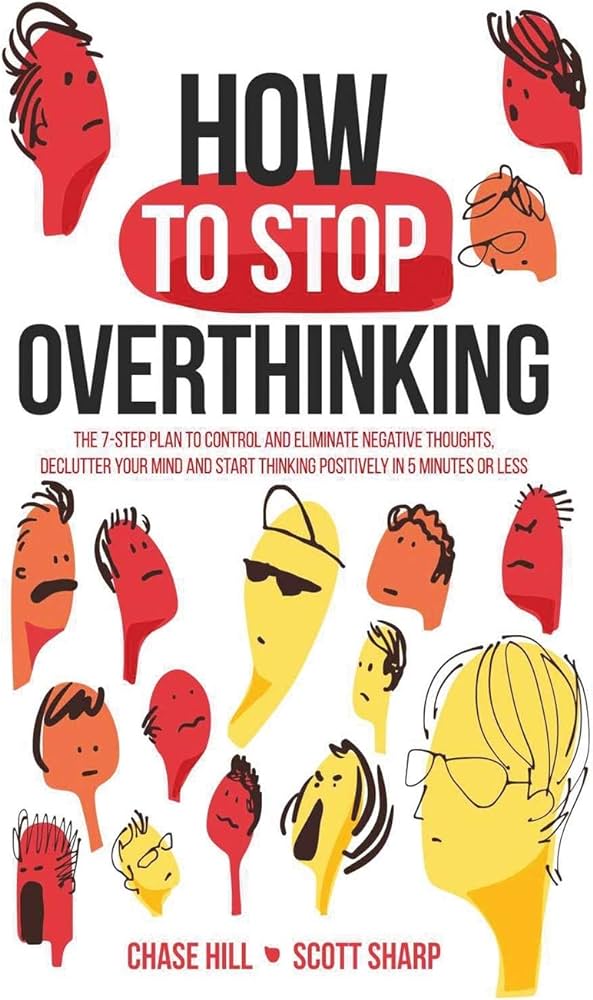"How to Stop Overthinking" by Chase Hill - How To Manage Overthinking
Eliminating negative thoughts, getting rid of the noise in our head, and making space for positivity does not happen overnight. But it is possible with consistent reflection and presence. Read on to find out you can break free from the clutches of overthinking and gain control over your thoughts.

Amid the hustle and bustle of modern life, overthinking has become a common pitfall. The unceasing mental chatter, the persistent scrutiny of every choice, and the never-ending loop of anxiety can sap our mental energy and emotional well-being.
But what if there was a way to break free from the clutches of overthinking and regain control over our thoughts and emotions?
Whether you find yourself caught in the grip of overthinking or simply wish to enhance your mental well-being, if you've been feeling stuck recently and have found yourself getting frustrated in your own negative thought patterns, read on to find out more about how you can unlock the tools to master your mind, embrace clarity, and create a life driven by intention rather than endless rumination.
What is the Book About?

The book "How to Stop Overthinking: The 7-Step Plan to Control and Eliminate Negative Thoughts, Declutter Your Mind, and Start Thinking Positively in 5 Minutes or Less" by Chase Hill and Scott Sharp is a guide that aims to help individuals overcome the habit of overthinking and cultivate a more positive mindset.
“Overthinking is when you cannot seem to get something off your mind, and you have uncontrollable or intrusive thoughts that don’t seem to go away. It is when you catastrophize everything around, or you are unable to think clearly due to the obsessive amount of thoughts overloading your mind. To overthink means you are focusing on what could be, what should have happened, or the “what ifs” in almost every situation.” — Chase Hill
The book presents a practical, step-by-step approach consisting of seven strategies to address overthinking and its negative impact on mental well-being. It offers tools and techniques to regain control over one's thoughts and break free from the cycle of rumination and worry.
The authors emphasize the importance of decluttering the mind by identifying and challenging negative thought patterns. They provide insights into the root causes of overthinking and offer strategies to reframe and redirect thoughts in a more positive direction. Furthermore, the book highlights the significance of mindfulness and self-awareness as essential tools for managing overthinking. It introduces simple exercises and practices that can be incorporated into daily routines to promote a calmer and more focused mind. The authors also address the role of self-care and self-compassion in combating overthinking, emphasizing the importance of nurturing oneself and developing a supportive inner dialogue.
What Are The Signs Of An Overthinker?
It's important to note that occasional bouts of overthinking are normal. However, if these signs are consistently affecting your daily life, relationships, and overall well-being, it may be beneficial to seek support or employ strategies to manage and reduce overthinking:
1. Persistent and Intrusive Thoughts
Overthinkers often experience a constant stream of thoughts that tend to be repetitive and difficult to control. These thoughts may revolve around past events, future scenarios, or a range of worries and uncertainties.
2. Analysis Paralysis
Overthinkers may struggle with making decisions due to excessive analysis and weighing of options. They may constantly second-guess themselves, fear making mistakes, or worry about potential negative outcomes.
Photo by Towfiqu barbhuiya / Unsplash
3. Difficulty Letting Go
People who tend to overthink find it challenging to let go of past mistakes or failures. They may replay events in their minds, dissecting every detail and seeking alternative outcomes. This can lead to prolonged feelings of guilt or regret.
4. Tendency to Overanalyze Social Interactions
Overthinkers tend to overanalyze their social interactions, replaying conversations and interactions in their minds. They may excessively worry about how they are perceived by others or interpret situations negatively, even when evidence suggests otherwise.
5. Perfectionism
Overthinkers may have a strong desire for perfection and set unrealistically high standards for themselves. They often scrutinize their work or actions, striving for flawlessness and feeling unsatisfied with anything less.
6. Difficulty Sleeping
Overthinking can interfere with sleep patterns. Overthinkers may struggle to quiet their minds and find it challenging to fall asleep or stay asleep due to racing thoughts.
Photo by Annie Spratt / Unsplash
7 Tips To Stop Overthinking
1. Be Present
Being present refers to the practice of being fully engaged and focused on the present moment, rather than dwelling on the past or worrying about the future. It involves paying attention to your surroundings, sensations, and thoughts without judgment or attachment.
Being present can be an effective strategy in managing overthinking tendencies. By directing your attention to the present moment, you can reduce the tendency to ruminate on past events or fret about what may happen in the future. This can provide a sense of relief from the cycle of overthinking and promote a greater sense of calm and clarity.
Being present can also help you become more aware of your thoughts as they arise. By noticing your thoughts without getting entangled in them, you can gain a sense of detachment and perspective. This awareness allows you to consciously choose which thoughts to engage with and which to let go, helping to break free from overthinking patterns. It also fosters a greater connection with your immediate experiences and the people around you. It allows you to fully engage in conversations, activities, and daily tasks, enhancing your overall quality of life and promoting a sense of fulfillment.
2. Release The Need For Control
Releasing the need for control is a key aspect of managing overthinking and reducing its grip on our minds. Often, overthinkers feel compelled to control every aspect of their lives, constantly seeking certainty and trying to predict and manipulate outcomes. This desire for control can lead to heightened anxiety and perpetuate the cycle of overthinking.
Photo by Luca Upper / Unsplash
Recognizing that uncertainty is a natural part of life and that we cannot control every outcome allows us to let go of the need for control. Accepting that some things are beyond our control can alleviate stress and free up mental space for more productive thoughts. Releasing the need for control involves developing trust in ourselves and in the natural unfolding of events. Trusting that things will work out in their own time and that we have the ability to handle whatever comes our way can help reduce the urge to overthink and control every situation.
Letting go of control requires cultivating a mindset of flexibility and adaptability. Understanding that plans may change, circumstances may shift, and unexpected outcomes can arise allows us to adapt and find new solutions instead of becoming paralyzed by overthinking.
3. Challenge your thoughts
Challenging negative thoughts and shifting focus to best-case scenarios is a common cognitive technique used in managing overthinking and promoting a more positive mindset.
The first step is becoming aware of your negative thoughts. Notice when you're engaging in overthinking or when your thoughts are primarily focused on worst-case scenarios. Once you identify negative thoughts, the next step is to challenge their validity. Ask yourself if there is evidence to support these thoughts or if they are based on assumptions or irrational fears. Explore alternative explanations or more balanced perspectives that counteract the negativity.
After challenging negative thoughts, intentionally shift your focus to best-case scenarios. Visualize positive outcomes and consider the possibilities that exist beyond the negative assumptions. This shift can help reframe your mindset and redirect your thoughts towards more constructive and optimistic thinking. Once you've envisioned the best-case scenario, think about actionable steps you can take to make it happen. Break down the desired outcome into smaller, manageable goals and develop a plan to move towards them. This process can empower you and provide a sense of agency in creating positive outcomes.
1. What would the worst possible outcome be, if this thought were true?
2. What facts support this thought? What existing evidence contradicts it?
3. Am I using a past experience to overgeneralize?
What am I ready to accept about this event or person?
In the moments that you find yourself thinking about the worst-case scenarios, practice by switch your thoughts to thinking of the best-case scenario and how you can make it happen. Make it a practice to write about the best-case scenarios and outline how it can happen for yourself.

If you're finding it hard to put your pen to paper in these situations, or if you're looking for a place to start journaling to help you through this, there is no better place than Journey for that. With a digital diary app like Journey, you can free-write and brainstorm about all the possible scenarios that can come out of your current situation in any way, shape, or form. You can also make use of the multiple writing tools in the Journey editor; like adding tables, lists, images, or make use of colors to gain more clarity in your thoughts. With journaling, take a step back to realize and understand that even though at times life gets too overwhelming, you’re just a human who can’t control what happens in the world, but you can master your own thoughts.
4. Practice Mindfulness
Mindfulness is often considered a powerful tool in addressing overthinking and cultivating a more present and focused mindset.

It involves developing a heightened awareness of the present moment, including your thoughts, sensations, and emotions. By practicing mindfulness, you can become more attuned to the patterns of overthinking and catch yourself when you start to ruminate or get lost in excessive thoughts.
Mindfulness also encourages observing your thoughts and experiences without judgment or attachment. When applied to overthinking, this non-judgmental perspective helps create distance from your thoughts, allowing you to view them more objectively and avoid getting caught up in them.
Overthinking often involves a repetitive cycle of thoughts that pull you away from the present moment. Mindfulness teaches you to refocus your attention on the present, whether it's your breath, sensations in your body, or your immediate surroundings. This helps break the pattern of overthinking and directs your attention to the here and now. Mindfulness also accepting your thoughts and emotions as they are, without trying to control or suppress them. It teaches you to acknowledge and allow your thoughts to pass through your mind without becoming entangled in them. This acceptance and letting go can reduce the grip of overthinking and create a greater sense of ease.
5. Find Ways To Distract Your Mind
“When you focus on other people or other things, you are more likely to spend your time doing something different than overthinking and worrying about something.” — Chase Hill
Participating in activities that you find enjoyable or fulfilling can help occupy your mind and provide a positive outlet for your energy. Distractions like this can serve as a way to shift your attention away from repetitive thoughts and engage your mind in a different activity or topic. This can range from hobbies, creative pursuits, physical exercise, or spending time with loved ones. By intentionally redirecting your focus, you create a temporary break from the cycle of overthinking. Some distractions can incorporate mindfulness practices. For example, engaging in activities like meditation, deep breathing exercises, or mindful movement can help calm your mind, promote relaxation, and reduce the intensity of overthinking.

While distractions can be helpful in managing overthinking, it's important to find a balance. Over-reliance on distractions may serve as a temporary relief but may not address the underlying causes of overthinking. It's crucial to combine distractions with other strategies, such as mindfulness or cognitive techniques, to develop a more comprehensive approach.
6. Start a "Worry Book"
A worry book provides a designated space to express and release your thoughts and worries. It can serve as a safe outlet for capturing and exploring your concerns without judgment or fear of repercussions.
When overthinking becomes overwhelming, write down your worries in your anxiety book. This act of transferring your thoughts onto paper can help externalize them and create a sense of distance, allowing you to gain perspective and clarity. Reviewing your worry book from time to time can also provide insights into recurring thought patterns, triggers, and the impact of overthinking on your well-being. It allows you to identify common themes and explore potential solutions or alternative perspectives.

As you write in your worry book, you can begin to challenge negative or irrational thoughts. This involves questioning the validity and evidence supporting your worries, as well as considering alternative, more balanced viewpoints.
Beyond documenting worries, your worry book can be a space to brainstorm solutions and devp action plans. By shifting your focus from rumination to problem-solving, you can actively address the concerns that contribute to overthinking. The act of writing in a worry book can provide a sense of emotional release and catharsis. It allows you to process and express your emotions, providing a form of self-therapy and promoting a sense of relief.
7. Remove Toxicity From Your Life
To combat overthinking and negative thought patterns, the importance of identifying and acknowledging toxic relationships in your life becomes paramount. This includes individuals who consistently bring negativity, drama, or excessive stress. Recognizing the impact of toxic relationships on your well-being is a crucial step in addressing overthinking.
Photo by Gabriel Benois / Unsplash
Establishing healthy boundaries is a key aspect of removing toxicity. The authors may offer guidance on how to communicate your needs, assert yourself, and protect your mental and emotional well-being. Setting boundaries can help prevent overthinking triggered by interactions with toxic individuals. Actively seeking out positive influences and supportive individuals. Surrounding yourself with people who uplift and inspire you can also create an environment that promotes healthier thinking patterns and minimizes overthinking triggers.
In the book, they authors also address the significance of letting go of negative patterns, habits, or environments that contribute to overthinking. This could include reassessing your habits, evaluating your living or working environment, and making changes that foster a more positive and conducive atmosphere for mental well-being.
By following the seven tips outlined in the book, this book allows us to believe that we can learn to take control of our thoughts, reduce overthinking, and foster a more positive mindset. Ultimately, it motivates us to achieve greater mental clarity, emotional well-being, and the ability to approach life's challenges with a more optimistic outlook. With the 7 steps that Hill and Sharp outline in the book, you can practice analyzing your situation, replacing negative things with positive things, finding your purpose, finding your passion and desire, rewarding yourself, being okay with mistakes and getting professional help if you find it necessary.
We are only ever promised today, so instead of obsessing over what you could have done at that social event or trying to control what you will do in your next appointment, learn to breathe in this moment you have now.







